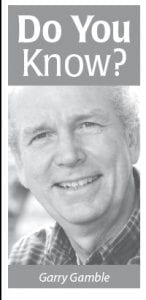If you ask School Trust Land Administrator Aaron Vande Linde, “What lies ahead for school trust lands?” he’s quick to respond, “I have a duty to make these properties productive”; adding, “I was advised before I took this position, ‘Never be a trustee. The standard is too high.’ “
I would agree. He’s in one of those “no-win” positions that contributes to premature graying . . . if not loss of hair altogether. Especially when the state has an obligation to manage for both the current as well as future beneficiaries.
During my term as county commissioner the topic of school trust lands came up only occasionally; once when Aaron made the drive up to provide an update on trust funds, grabbed a donut and headed back; the other when former U.S. Forest Service Supervisor Brenda Halter came before the county board, September 8, 2015, to rally support for a 2012 proposal, authorized by the state legislature, to transfer 83,000 acres of school trust land, located within the Boundary Waters Canoe Area (BWCA), to federal ownership.
Referred to as a “hybrid” model, it sought to combine the outright purchase of 53,000 acres with an exchange of 30,000 acres. I was certainly in support of a land exchange as this would be consistent with the 1964 Wilderness Act, which states, “State-owned land or privately owned land shall be exchanged for federally owned land in the same state of approximately equal value.”
I was opposed, however, to any outright purchase. Ms. Halter’s response was, “Well it doesn’t specifically say that we can’t purchase. It says, ‘shall’ be exchanged.” . . . which is why shall is among the most heavily litigated words in the English language. In fact, a perusal of the “popular” Federal Plain Language Guidelines (p. 25) referred to in the Federal Plain Writing Act of 2010 – yep, there’s actually an act – states, right there in plain English, “every federal department [is directed] to use ‘must,’ not ‘shall’ to indicate requirements.” Pretty much confirms the “Gumby-like” nature of this word.
I “shall,” “will,” “must” remember that in the future.
Subjective interpretation comes in handy when federal wilderness restrictions complicate the state’s ability to manage the lands for long-term economic return which, I believe, we’ve mentioned several times before, is the mandate of the school trust. Trust Administrator Vande Linde even concedes, “The Wilderness Act and subsequent acts have ‘hamstrung’ the state’s ability to manage trust lands,” referring to them as “sideboards” that have been put in place.
While Cook County commissioners passed the “hybrid” model resolution 4-1, we were the only county, directly affected by this proposal, to do so; St. Louis and Lake counties chose to step back from direct support.
With 92 percent of Cook County lands controlled by government, we should be exploring ways to increase our tax base or generate additional revenues from government-owned properties, when it comes to land exchanges. As demonstrated in the recent – still pending – land swap with the Forest Service for the remaining county-owned acreage within the BWCA. The county board passed a resolution August 18, 2009, identifying priorities for the exchanged lands; namely, lands are to be used for communication tower sites, fire halls, gravel resources, septage disposal areas and recreation/ development areas (I don’t believe septage, and recreational areas are one in the same) affordable housing, cemetery and economic development sites.
I’ve consistently held that proposals and subsequent policies or actions should fit local context. Remove the local actors, and you lose this context.
Consider St. Louis County’s major land exchange (June 2014), which included 11,637 acres of school trust land. It established the largest private wetland mitigation bank in the nation. Known as the Sax-Zim Bog, the new wetland bank covers 33 square miles in what’s acknowledged as one of the most important bird habitats in Minnesota.
“This just makes sense for us to do,” said Frank Jewell, the county commissioner representing central Duluth. “The bog wins, the forest wins, wildlife wins … and the county wins. . . . Development is going to happen whether we do this or not, so let’s keep the benefits here in the county.” Can I hear an Amen?
St. Louis County officials saw the opportunity and acted upon it. Spearheaded by former St. Louis County Land Commissioner Bob Krepps who, to his credit, recognized the land within Sax-Zim Bog was “great for birds but lousy for providing revenue for the school trust and the county.”
That’s changed . . .
According to Steve Hobbs, Minnesota state director for Conservation Acquisition, “It gives school districts throughout Minnesota more money at a time when budgets are tight. The project allows the school trust and St. Louis County to manage forests in a sustainable way that provides jobs in a region hard hit by the Great Recession and continuing sluggishness in the world economy. The creation of the Sax-Zim Bog wetland mitigation bank gives regulators better options to mitigate impacts to our wetlands. Most amazing is that this was all done without spending a dollar of public money on the acquisition of the land or its restoration.”
Aaron Vande Linde agrees. “It’s a win, win, win combination.”
Who knows, Aaron, more creative outcomes like this might even slow the graying process.
Former Cook County Commissioner Garry Gamble is writing this ongoing column about the various ways government works.



Loading Comments